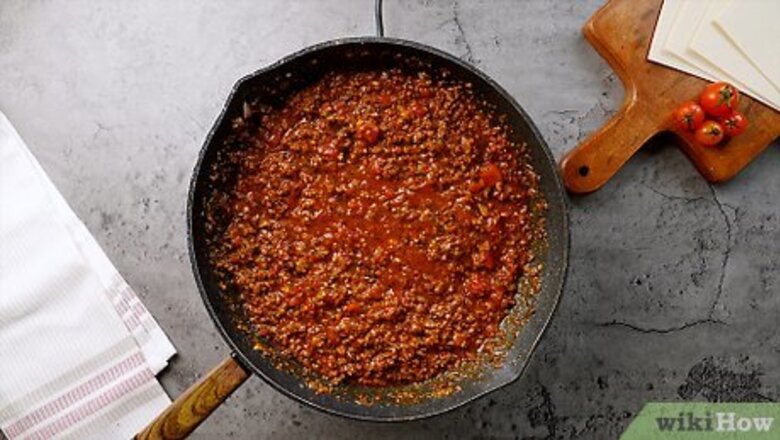
views
- Let your lasagna cool to room temperature (whether it’s baked or unbaked) in a tempered glass or aluminum baking dish that can be frozen and put in the oven.
- Wrap the lasagna and the dish tightly with plastic wrap, then wrap a layer of aluminum foil to prevent freezer burn. Freeze for up to 3 months.
- To reheat, thaw your lasagna in the fridge overnight, then let it sit at room temperature for 30 minutes. Bake at 375 °F (191 °C) for 60-70 minutes and serve.
Freezing Unbaked Lasagna
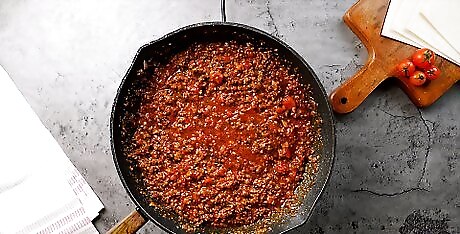
Make a lasagna recipe using fresh ingredients instead of frozen ones. When ingredients are frozen and thawed multiple times, their flavor and texture suffer and the chance that the food could be contaminated by bacteria increases. A lasagna recipe made with fresh, never-frozen ingredients will still taste great after freezing whether it was frozen baked or unbaked. For example, don't plan on freezing lasagna made with sausage or ground beef that was previously frozen. Instead, use fresh meat or leave it out completely. If your favorite lasagna recipe calls for a frozen ingredient, the final dish usually won't be too affected by substituting the fresh version instead. For example, instead of using frozen mushrooms, just use fresh. In most cases you will have needed to thaw them anyway. Consider preparing two lasagnas at once—one to bake and eat right away, and another to freeze and bake later for a quick and easy dinner. This will save you a lot of preparation time and effort.
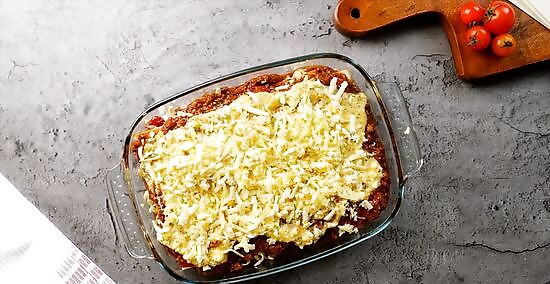
Assemble the lasagna in a baking dish that can be frozen. Look for a "freezer-proof" label on your dish or use a tempered glass or tempered ceramic pan (untempered dishes might crack in the freezer because of the rapid temperature change). Alternatively, prep the lasagna in a disposable aluminum baking pan. That way, you don’t have to worry about cracking and your other dishes will be free to use while the lasagna is in the freezer. If you don't have a dish you can freeze long-term, place a layer of parchment paper at the bottom of your prep dish (before you layer your lasagna) with a few inches hanging over each end. Then, pop the dish in the freezer uncovered until the lasagna is frozen solid. Use the parchment paper to lift the lasagna out of the dish, then wrap it in plastic and foil and return to the freezer. Follow your recipe’s directions, or stack the lasagna as follows for at least 3 layers: sauce, pasta, meat, cheese.
Let the lasagna cool to room temp if you added hot ingredients. If your recipe uses pre-cooked noodles, meat, seafood, or vegetables before baking, let the assembled lasagna sit until the entire dish is about room temperature. The exact amount of time depends on how much “hot stuff” is in there—a piping hot meat sauce fresh from the stove may take 30 minutes or so. This way, no ice crystals will form inside the lasagna when it freezes, which preserves the texture. To speed up cooling, place the lasagna in the refrigerator to chill. Consider using no-boil noodles when you plan to freeze a lasagna (just makes sure to use plenty of sauce so they have liquid to cook in when you reheat it).
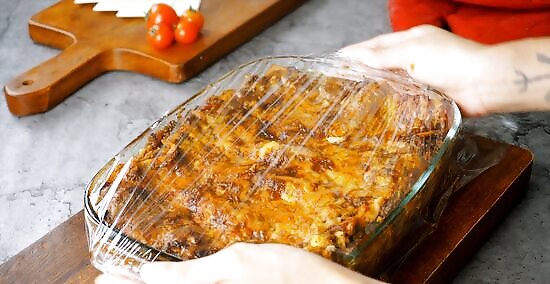
Cover the lasagna and pan with plastic wrap and aluminum foil. First, wrap the entire lasagna, including the dish, in a layer of plastic wrap. Leave as little space as possible between the top layer of the lasagna and the plastic to eliminate air pockets that could cause freezer burn. Then, add a layer of aluminum foil over the plastic for extra freshness and protection. Alternatively, use two layers of foil instead of plastic and foil. No matter what, make sure the lasagna is double wrapped to prevent it from drying out.
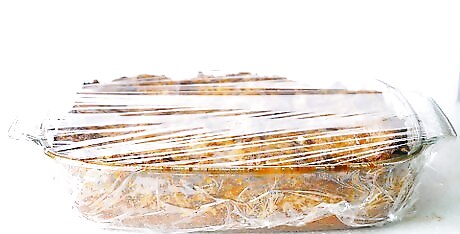
Label and freeze the lasagna for up to 3 months. Place a label on top of the foil with the recipe name and date, or write on the foil with a permanent marker (just be careful not to puncture the foil while you write). Even though it will be safe to eat for longer, aim to reheat your lasagna within 3 months for the best taste and texture. The 3 month-rule applies to all fillings, including meat, seafood, or vegetables.
Freezing Baked or Leftover Lasagna

Let your baked lasagna or warm leftovers cool to room temperature. Leave your lasagna on the countertop to cool (a piping hot lasagna straight from the oven may take up to an hour, while leftover slices may take 30 minutes or less). Putting hot leftovers in the freezer can lead to condensation that freezes into crystals and makes the texture of the lasagna worse when you reheat it. To speed up the cooling time, try putting a layer of plastic wrap over the lasagna and setting it in the fridge to chill.
Wrap the lasagna in plastic and foil, or put individual slices in bags. Wrap a baked lasagna the same way you’d wrap an unbaked one—wrap it inside of a freezer-safe dish with plastic, leaving as little space as possible between the top layer and the plastic, then add a second layer of foil. Depending on how much you have left, try placing the leftovers in a resealable freezer bag (squeezing out as much air as possible before zipping the bag closed). Alternatively, consider cutting the lasagna into individual portions and freezing them in bags or airtight containers. This way, you won't have to reheat the entire thing if you only need a meal for one or two people. Wait until the lasagna has chilled to cut it up (this helps the pieces hold together) and put each piece in its own bag or container.
Label and freeze your baked lasagna or leftovers for up to 3 months. Include the recipe and date on a label and stick it to the foil, or write directly on the foil with a marker (being careful not to puncture the foil while writing). Your baked meat, veggie, or seafood lasagna will taste great up to 3 months, but may still be safe to eat up to 6 months or longer.
Reheating Baked or Unbaked Lasagna

Thaw the frozen lasagna in the refrigerator overnight. While a lasagna can be reheated or cooked from frozen, it’ll need less time in the oven and cook more evenly if it’s fully thawed. The night before you plan to eat it, transfer it from the freezer to the fridge (still wrapped in foil). Tip: If you forget to thaw your lasagna ahead of time, don’t worry. Remove the plastic wrap, cover the lasagna in foil, and double the baking time indicated on your recipe. Only do this if your lasagna was frozen in a disposable aluminum pan or a tempered dish (the rapid temperature change will crack untempered glass or ceramic pans).
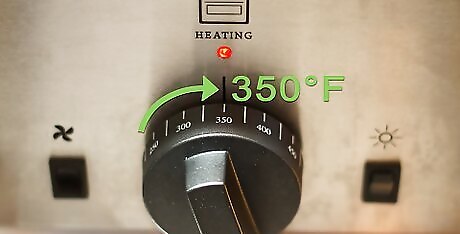
Let the lasagna sit at room temp while the oven preheats to 375 °F (191 °C). If your recipe indicates a specific oven temperature, go with that. If you’re unsure 350–375 °F (177–191 °C) is a reliable, standard cooking temperature for lasagna.
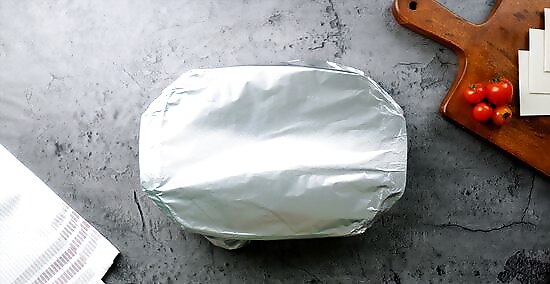
Remove the plastic wrap and cover the baking dish with foil. This will keep the top from getting too brown while the rest of the lasagna cooks. If you're cooking an individual portion of lasagna, take the piece you want to bake out of its storage bag and place it on a suitable baking dish, then cover with foil. Wrap the foil tightly to keep steam inside the dish as the lasagna heats up. This will keep it from drying out and helps ensure the noodles cook.

Bake the lasagna for 60-70 minutes, then 10 minutes without foil. After about an hour in the oven, use a food thermometer to check the internal temperature of the lasagna. It’s fully heated through when the temperature is 165 °F (74 °C) and the sauce is bubbling around the edges. Remove the foil from the dish and bake for an additional 10 minutes to crisp and brown the cheese on top. Depending on your oven, the dish you’re using, and the starting temperature of your lasagna, the baking time may be slightly shorter or longer. If you're just reheating one piece of lasagna, try the microwave instead of in the oven. Place it on a microwave-safe dish and microwave on high for 2-3 minutes, or until it's hot and bubbly. Do not use aluminum foil in the microwave.

Serve your delicious, cheesy lasagna! Let your lasagna sit and cool for about 10 minutes before serving (this makes it easier to cut, and it won’t burn your mouth once you dig in). To freshen it up, try sprinkling some extra cheese on top or adding a drizzle of pesto or olive oil. In case it dried out a bit, warm up some extra sauce and serve it on the side. A sprinkle of some fresh parsley adds a nice touch, too!




















Comments
0 comment